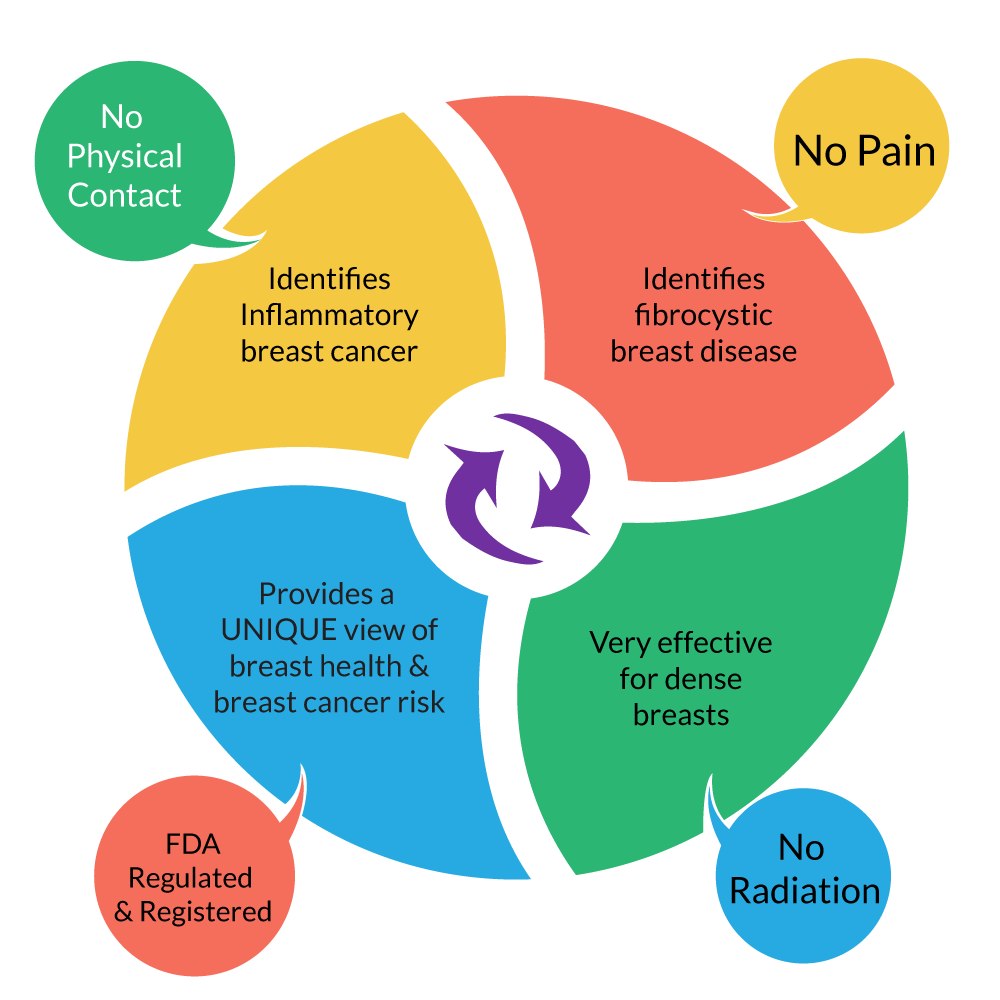
Why consider thermography?
Is Thermography Always Safe & Effective?
The FDA considers Thermography to be a safe practice. Thermography tests were FDA approved as of 1982 and are FDA regulated. However, thermography is still considered an “alternative screening option” for cancer and is not intended to replace other procedures.
Does Thermography Involve The Use Of Radiation?
Thermography is a safe procedure that does not use radiation to capture images.
Does Thermography Cause Any Pain Or Discomfort?
Thermography takes about 15-30 minutes to complete. There is no physical contact and is completely painless.
How Accurate Is Thermography?
No test is 100 percent accurate, however thermography is an excellent screening tool that is best used along with other detection methods and has about a 3% false-positive findings and a 90% sensitivity and specificity.
Do I Need A Prescription To Receive A Thermography Scan?
A Doctor’s prescription is not required.
How Does Breast Thermography Compare To A Mammogram?
Thermography and Mammograms are both imaging tests that do not specifically diagnose breast cancer. Mammography detects structural changes in the breast and can identify the exact location of a lump. While Thermography detects functional changes in the breast that occur much before structural changes in the body develops.
How Often Should I Have A Breast Thermography?
We recommend that you have a Breast Thermography scan once a year.
Why Do I Need A 3-Month Follow-Up Thermogram After My Initial Breast Screening?
Heat patterns in the breast are unique for every person. An accurate baseline image of your breast must be established before it can be determined that any changes are taking place in the breasts. A baseline cannot be established with only one image. With a 3-month follow-up screening, a comparison can be made between both images in order to determine that a woman’s breast function is stable and suitable to be used as a normal baseline.
Do I Still Need To Get A Mammogram?
Thermography is regulated by the FDA as an additional test to mammography, not as a stand-alone test. Thermography is not a substitute for mammography and mammography is not a substitute for thermography. When it comes to breast screening, there is no single test that will detect all cancers. However, breast cancer detection is as high as 98% for women who get thermography and mammograms.
What’s The Difference Between A Mammogram And A Thermogram?
Both tests can produce images of the breasts but are meant to produce different findings. Mammograms detect breast disease, and thermography detects your breast health, before disease starts. Mammogram images show the anatomy (structure) of the breasts and can tell if there is a lump present. Thermography images show the physiology (function) of the breasts and gives you a visual image of abnormal changes before there is a diagnosis of cancer.
Mammograms can detect cancer as small as a few millimeters. Thermography assesses your risk of developing cancer by measuring subtle changes in heat associated with disease. Thermography can detect functional changes associated with cancer while it is still at the cellular level, before it becomes visible on a mammogram. Thermography of the breast can detect abnormalities from 8-10 years before mammography can detect a mass.
Thermography offers you the chance to implement lifestyle changes and strategies to reverse factors that can lead to cancer. Mammography involves radiation and breast compression; thermography does not require either. There is no physical contact or radiation involved in thermography.
Can Thermography Detect Any Other Diseases Besides Breast Lump?
Thermography has been successfully used in the detecting Diabetes, Neuropathy and Peripheral Vascular Disorders. Thermography is used widely in sports medicine to detect inflammation where injuries occur. It has also been used to detect problems associated with Thyroid Disease, Vasculitis, Kidney Transplantation, Dermatology, Heart Disease, Neonatal Physiology and more.
Who Interprets Thermography Reports?
All Thermal Imaging reports are interpreted by Board Certified Medical Doctors who hold an additional certification in Thermology. These physicians are available to speak with your physician regarding the results of your report.
What Kind Of Certification Does You Thermographer Hold?
Thermographers should always hold a certification from an Accredited Professional School. All Thermography One technicians are trained and accredited through ACCT (American College Of Clinical Thermology) which is an accredited medical association.